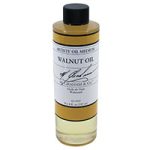You’ve probably tried some of the more common oil painting mediums.
Solvents like turpentine and mineral spirits for thinning paint and clean-up are crucial to the painting process and are a must when trying out oil painting. There’s also linseed oil, which is useful for improving paint flow and extending your working period.
BUT how about other solvents? Or other oil-type mediums? How about cold wax and alkyd resin?
You may not have tried them out previously, but they can be just as important to the painting process as the more commonly used mediums. It’s just a matter of learning what they can do for you.
Below, there’s a comprehensive guide to oil painting mediums that will tell you everything you need to know.
Continue reading to find the best oil painting medium for your current needs!
Contents
- Oil Painting Mediums at a Glance
- A Snapshot Of The Best Medium Brands to Use for Oil Painting
- An Overview Of All Oil Painting Mediums
- Solvents: Are They Necessary?
- Oils: Are They Necessary?
- Cold Wax: Is it Necessary?
- Alkyd Resin: Is it Necessary?
- FAQs
- What Is the Most Commonly Used Oil Painting Medium?
- Is it Necessary to Use Oil Mediums?
- When to Use Oil Paint Medium?
- How to Prevent Oil Paint from Cracking?
- What Does Fat over Lean Mean in Oil Painting?
- How Can You Seal Oil Paint?
- What Is the Best Consistency for Oil Painting?
- What Makes Oil Paintings Shiny?
- Final Thoughts
Oil Painting Mediums at a Glance
To start, let’s look at some of the most commonly used oil painting mediums in the market. They’ve been arranged in the table below, with four sections to differentiate the different types of oil paint mediums:
Medium Type
Touch Drying Time
Transparency
Viscosity
Toxicity
Solvents
30 hours
Increases durability, even finish, best for glazing
High
Moderately Toxic
24 to 30 hours
Increases transparency, strengthens bond between layers
Low
Non-Toxic
Oils
4 days
Increases durability, increases transparency, adds shine
Medium
Non-Toxic
Cold Wax
48 hours
Thickens paint and results in smooth matte finish
Medium
Non-Toxic
Alkyd Resin
24 hours
Adds shine, improves bond between paint layers, increases transparency
Low
Non-Toxic
24 to 72 hours
Increases durability, non-yellowing, makes the paint more flexible
Medium
Non-Toxic
18 hours
Increases durability, increases transparency, makes paint more flexible, produces satiny finish
Low
Non-Toxic
A Snapshot Of The Best Medium Brands to Use for Oil Painting
If you’re in a hurry or are just curious about which mediums to look out for, below is a chart of the best mediums and their purposes. Of course, if you want to find out why these particular brands were chosen for each category, make sure to read till the end for more information!
Product
Strength
Product Details
Best Paint Thinner
- Non-toxic solvent with no harmful or offending aromas (the scent of lavender is soft and pleasant).
- Powerful pigment dispersing ability, improving paint flow and adding transparency.
- Increases bond between oil paints, making the resulting painting more durable.
Best Oil-Type Medium
- More effective than regular linseed oil at slowing drying time, allowing you more room to work with.
- The resulting finish is glossy, making colors more vibrant and luminous.
- Cold-pressed oils generally have higher acid content — which means it works very stably with oil pigments, allowing you to work easily.
Best Cold Wax
- Professional grade cold wax of the highest quality, made by Michael Harding’s — one of the most famous oil paint manufacturers.
- A mixture of linseed stand oil and turpentine, which makes paint more elastic and easy to work with.
- Results in a unique, satiny finish perfect for textured and defined works.
Best Alkyd Resin
- Makes oil colors thicker, allowing you to paint with more body and texture.
- Fast-drying medium — fastest drying out of all available alkyd mediums.
- Produces a silky, shiny film that makes the paint more flexible and prevents yellowing.
Best Fast-Drying Oil Medium
- Accelerates drying time so you can build up layers faster and meet deadlines sooner.
- Improves the flow of paints so that you can improve your control over your brushwork.
- Non-yellowing and highly stable product, allowing you to preserve your artwork for longer periods.
M. Graham Walnut Oil Medium
- Unlike most other oil-type mediums, Walnut Oil works as an effective brush cleaner, allowing artists to work solvent-free.
- Walnut oil reduces paint viscosity, increasing flow to enable you to create luminous, transparent glazes.
- Walnut oil is also non-yellowing, an attribute rarely seen in other oil-type mediums.
An Overview Of All Oil Painting Mediums
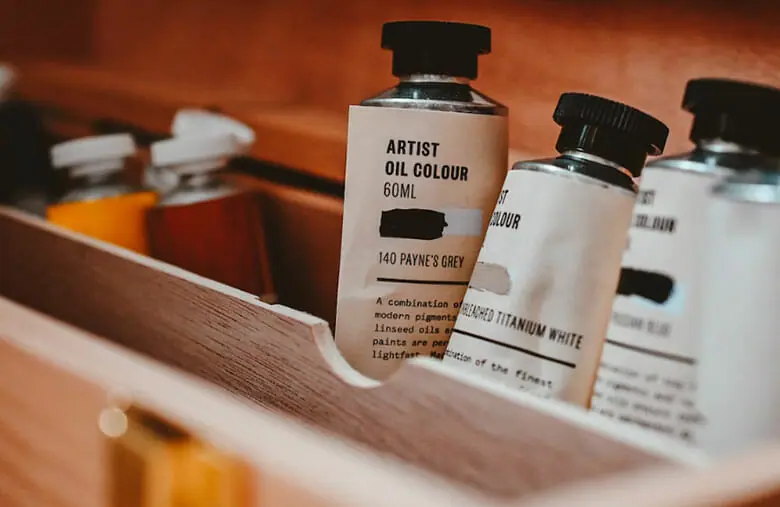
First, let’s answer a question:
What Are Oil Paint Mediums?
Mediums are oil painting supplies that you can add to your oil paint to modify its performance. For example, you can thin paint with solvents, add volume with cold wax, enhance paint flow with oils, speed-up drying time with alkyd resins, and so forth.
Each medium will change how you paint, allowing you to work more flexibly and precisely than when working straight out of the tube.
Why Use an Oil Paint Medium?
Why should you use oil mediums?
The simplest answer: Mediums offer convenience and increase your creative freedom.

In the late 1700s, painters J.M.W. Turner and Joshua Reynolds experimented with their oil paints to figure out how to let them dry faster to create finished works sooner.
If you’ve painted with oil paints before, you’ve probably experienced the pain of waiting hours for a layer to dry before moving on to the next one.
For classic oil painters like Turner and Reynolds, it was even worse! A single paint layer could take weeks — if not months — to dry. So, they figured out a solution!
By experimenting with oil painting mediums recipes, they not only created a formula that allowed their layers to dry quicker. But also opened up a new way of producing oil paintings.
With “Gumption” in their hands, they were able to build up luminous glazes that added a sense of depth and majesty to their work without having to wait years in order to see it completed.
How Do Artists Choose Their Medium?

To figure out how to choose which painting medium is most suitable for you. You first need to think about what you want to achieve. The following are examples of why artists may choose a certain medium based on their preferences:
1. Versatility
Do you want to improve your creative freedom? Or do you want to try out new techniques? Experimenting with mediums is one way to achieve this.
For example, if you wish to add impasto effects to your painting, you can use a cold wax medium (like beeswax paste — which will thicken your paint).
On the other hand, if you want to paint thin, transparent glazes, you’ll want to add more oils or alkyd resin to your oil paint.
2. Slow Drying Time
Although waiting for oil colors to dry between layers can be quite annoying, this slow drying time can give you more time to manipulate your painting to be exactly how you want it to be.
Oil-type mediums can allow you to extend your work time so that you won’t ever have to worry about ruining your painting because of a lack of time.

3. Speed Up Drying Time
Of course, just as you can slow the drying period to allow more work time, you can also use a fast-drying oil medium to enable your paints to dry sooner. This is good for painters working on a deadline or those who like to build up transparent glazes.
In any case, by choosing the right oil painting medium, an artist can control how fast or slow their painting dries.
4. Blendability
If you’ve worked with student-grade oil paint before, you probably know how difficult it is to blend. This is a problem you occasionally see in certain artist-grade paints as well, primarily because of the pigments and binders used.
Having solvents and oils on hand as oil painting mediums to improve flow can completely solve this problem — allowing you to work more fluidly than you would straight out of the tube.
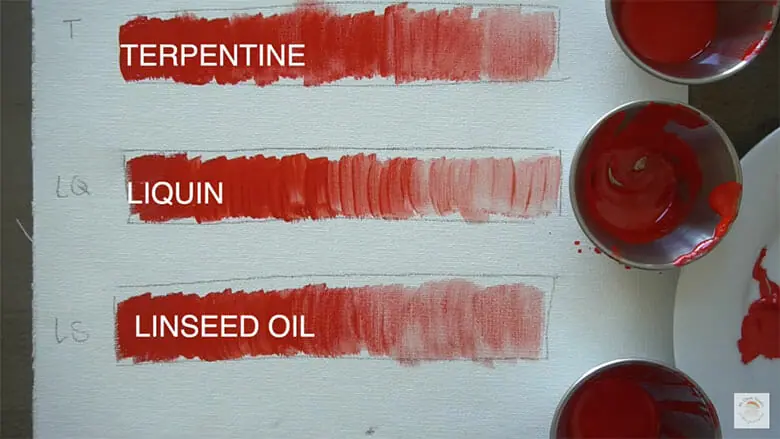
5. Color Concentration
High-quality paints straight out of the tube are concentrated colors with high saturation. This vibrancy may or may not be what you’re looking for.
Either way, you can control the concentration of pigments in your paintings with the proper application of oil mediums — allowing you to fully realize your dream painting.
6. Durability
Despite the well-known durability of oil paintings, there will always be a time when they’ll start to fall apart. Certain mediums, like Alkyd Resins, can help increase the life expectancy of a painting by producing a hardened paint film that protects the paint from deteriorating.
And so, it’s important to remember what characteristic you want in an oil painting medium when deciding whether or not it’s necessary for your work process.

Solvents: Are They Necessary?
When it comes to mediums for oil paints, solvents are one of the most commonly used.
Why? Well, outside of the fact that solvents are quite crucial for cleaning up your equipment after painting, it has to do with the properties of solvents:
- Thin paints
- Increases transparency
- Improves paint flow
- Speeds up drying time
- Results in a matte finish
Solvents can thin paints and improve flow so that you can paint layers more smoothly. This feature is especially useful when working on your underpainting as it can prevent you from creating brush strokes in the background of your painting that are too eye-catching.

As for the resulting matte finish, this has to do with how the solvent reacts with the oil in your oil paint. Solvent reduces oil content, which is why the appropriate use of solvents can produce a smooth matte finish. Of course, you have to be careful, as too many solvents in your oil colors will make it chalky and more likely to crack.
To avoid this, you’ll have to study and practice the “fat over lean” rule to avoid causing instability in your work (the basic principle is adding more oil to each layer).
Also, note the fact that most solvents are quite toxic. So, when choosing what kind of solvents to use, you’ll need to consider your current working conditions — is it well-ventilated? If not, you’ll either have to avoid toxic solvents or figure out how to ventilate your workspace.
Turpentine

Turpentine is the one artists are most familiar with when talking about solvents.
It’s been around since the 1800s, and aside from being used as an oil painting medium, it was previously used in medicines, lamps, and processing rubber.
In terms of usability, there’s no denying its advantages. Most people use it to thin oil paint and improve paint flow, which it is great at — the pigments are perfectly distributed, allowing one to paint a thin layer without much effort.
The only issue, as mentioned, is that it is quite toxic. Inhaling its fumes will make you dizzy, and it’s best to avoid placing it near children and pets.
As an additional note, be sure to check the properties of the turpentine that you buy. It’s best to find artist-grade turpentine — specifically, distilled turpentine. Anything else can introduce impurities into your oil painting and cause yellowing.
Winsor & Newton Distilled Turpentine
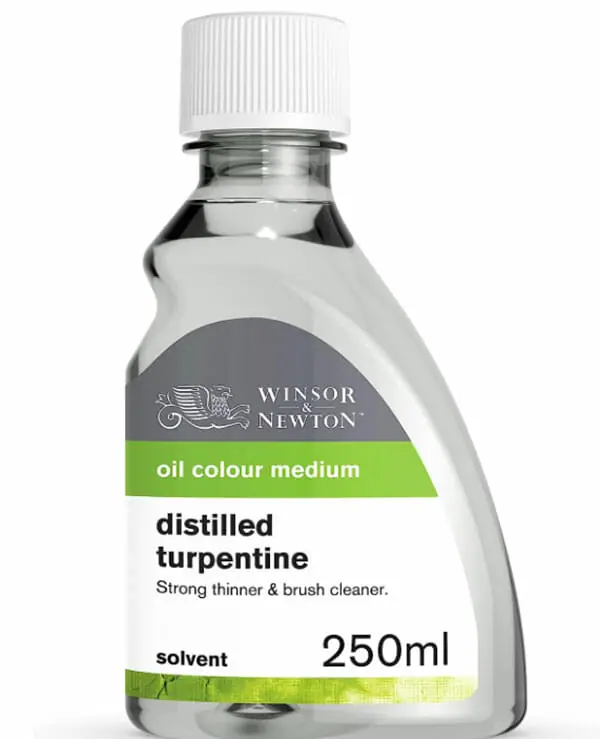
Winsor & Newton’s distilled turpentine is a fast-evaporating, professional-grade solvent. Most artists use it to thin paint and clean their brushes after working. It produces a glossy finish, is mixable with other oil painting mediums, and can be used to remove varnishes and dried oil.
Pros
- Highly effective at thinning paint by dispersing pigments
- Professional-grade
- Also effective for acrylic and alkyd colors
Cons
- It may cause discoloration (may turn paint yellowish over time)
Odorless Mineral Spirits (White Spirits)
Although not as effective as turpentine when it comes to dispersing pigments, odorless mineral spirits also play their role as an oil painting medium.
For one, it’s still quite useful for thinning paint, and it doesn’t have as bad an odor and isn’t as toxic as turpentine (though, as a solvent distilled from petroleum, it’s still best to be careful when using it). It’s also much cheaper than turpentine, so most artists choose it over other oil paint solvents.
Just remember that because it’s a lot more abrasive than turpentine, using odorless mineral spirits indiscriminately may cause your oil colors to become brittle. Because of this, rather than using it as an oil paint medium, many artists leave it aside to use as a brush cleaner instead.
Artists’ Grade Gamsol Oil Color Mineral Spirits

Artist’s Grade Gamsol is a less toxic alternative to turpentine. It’s also important to note that this brand is 100% odorless, so you don’t have to worry about being dizzy from the fumes. However, you should still only use it in a well-ventilated area, as it is still somewhat toxic.
This product is used primarily for thinning paint for smoother brushwork and creating glazes.
Pros
- 100% odoless
- Great brush cleaner
- The highest concentration of mineral spirits
Cons
- Somewhat toxic, ventilated work area required
Oil of Spike Lavender
When it comes to solvents, oil of spike lavender is a classic choice. It is quite strong, stronger than turpentine, even. So, it’s more than capable of dispersing pigments. And, just like turpentine, it’s compatible with other oil paint mediums. It also improves the bond between your layers of paint, which increases the overall durability of your painting.
A little bit of oil of spike lavender also goes a long way, and it’s far safer to use than turpentine and doesn’t produce any offending fumes (in fact, it’s quite the opposite! It gives off a soft, pleasant lavender aroma.)
The only caveat is that oil of spike lavender is quite expensive. Though, as mentioned, a little bit of oil of spike lavender goes a long way. You only need a few drops each time.
Chelsea Classical Studio Lavender Spike Oil Essence

This is a natural alternative to turpentine — non-toxic and with a harmless lavender scent. Even just one or two drops can dilute the paint and allow you to blend more smoothly and create luminous glazes. Chelsea Classical Studio also guarantees that using their oil essence will make your paint layers bond stronger.
Pros
- Non-toxic solvent
- No harmful, offending odors
- Effective paint thinner
Cons
- Expensive
Zest-it®
Just like oil of spike lavender, our next oil paint solvent is marketed as a non-toxic alternative to turpentine. Zest-It is quite effective at thinning paint and is just as good at cleaning brushes. It’s just not as effective as turpentine or oil of spike lavender.
Plus, using too much may thicken your oil paint and cause it to become cloudy.
Oils: Are They Necessary?
If you’re a beginner, you might ask: Oil paint is made of oils, so what’s the point of using oils as oil paint mediums? Well, the answer is in the question itself.
Oil colors are made with a mixture of pigments and oil as a binder.
Each brand has its formulas and thus uses different types of oil (with linseed oil being the most commonly used), and the ratio of oil to pigments is also different.
In this way, you’ll find that different brands of oil paints will react differently to each other. Others blend more easily, and others may dry slower, and so on. This is closely related to the oils used in the creation of the oil paint itself and the ratio of oils used.
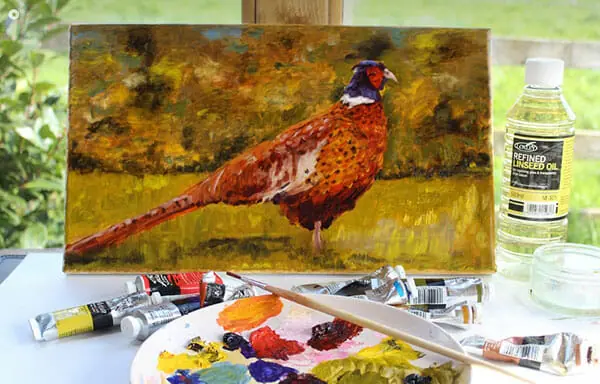
Using oils as an oil paint medium will allow you to control how your paint will react on canvas precisely. You can add more oils to give yourself more time to work on your painting. You can also hide your brush strokes in less conspicuous areas by adding a dab of oil to your brush.
This is not to mention the other benefits of oils as an oil paint medium. For example, it can make your colors more vibrant and more durable. It can also add texture and body to your paint so that you can create more defined works.
Refined Linseed Oil
Refined linseed oil is extracted from ripened flax seeds. They’re highly compatible with other oil paint mediums and are used for the following:
- Reducing paint viscosity to decrease drag
- Extend working time
- Add transparency for glazing
- Add a glossy finish to your painting
The only caveat with using refined linseed oil is that it may result in discoloration. More specifically, because refined linseed oil naturally contains linoleic acid (which makes it highly effective on oil paint), it can turn your painting a bit yellowish over time.
Have you ever seen particularly old paintings that look yellowish or brownish? The most common culprit for this is varnish. It can turn a whole painting yellow and will have to be wiped off manually. Linseed oil causes similar discoloration, though it’s not as bad.
Most of the time, you just have to bring your painting out to see the light and the discolored oil will be taken care of. But it’s a fact that it can ruin the aesthetics of a painting. Moreover, linseed oil is the most yellowing of all oils, so the effect is even more exaggerated.
Winsor & Newton W&N Refined Linseed Oil

Winsor & Newton refined their linseed oil to eliminate the impurities in raw linseed oil. This particular oil medium’s main property is to extend your work period by slowing the drying rate of your oil colors. It also allows you to modify the paint’s consistency—creating beautiful glazes with a high-gloss finish.
Pros
- Highly recommended by artists
- Low viscosity
- Beautiful finish
Cons
- It may cause discoloration (may turn paint yellowish over time)
Cold-Pressed Linseed Oil
If you want to take it to the next level, choosing cold-pressed linseed oil over regular refined linseed oil would be just right.
Cold-pressed linseed oil offers the same working properties as refined linseed oil, but it does it better. Whether it’s slowing the drying time, improving paint flow, adding a glossy finish, etc. Cold-pressed linseed oil is more effective.
You’ll also find that many of the artist-grade oil paint brands in the market use it as their binder. It has high acid content — making it more compatible with oil paint pigments than other oils.
Winsor & Newton Cold-Pressed Linseed Oil

Compared to the general refined variety, the cold-pressed oil produced by Winsor & Newton is much more expensive. It is produced by compressing and heating linseed oil, resulting in a medium that is yellowish and thicker in consistency. Its working properties are similar to the previously recommended product. However, its effects are generally stronger.
Pros
- Improves flow for more fluid painting
- Glossy protective finish
- Adds transparency
Cons
- More expensive than refined linseed oil
Linseed Stand Oil
By changing the production methods, linseed oil can become linseed stand oil. Based on the name, you might think that the two products are very similar, but in fact, they look and feel very different. Stand oil has the consistency of honey — it’s very thick, and a little goes a long way.
As for working properties, stand oil is not too different from other linseed oil types. Linseed stand oil also improves flow and leaves a glossy finish, and the resulting paint film is even better — there is less risk for discoloration.
The only catch is that stand oil is not as absorbent. You may notice that some areas in your painting will ‘sink in’ when you use it. This is caused by the stand oil overwhelming the paint pigments — leaving certain spots in your painting duller than others.
Gamblin Linseed Stand Oil

Gamblin’s stand oil is an even thicker version of regular linseed oil — with a consistency that is similar to honey. It is also a type of heated linseed oil polymerized to improve its properties. Its greatest advantage is that it is useful for adding more volume to oil colors. It should also be noted that it is the slowest drying among linseed oil mediums.
Pros
- Less prone to yellowing
- Improves flow
- Stand oil is cheaper than regular linseed oil
Cons
- Not very absorbent and may cause oil colors to sink into the canvas, creating dulled-out areas
Safflower Oil
As an oil paint medium, safflower oil is better at improving flow than linseed oil (because safflower oil results in an even lower viscosity). Safflower oil also produces a protective layer that keeps the paint underneath from wrinkling.
What’s unfortunate is that safflower oil is quite picky when it comes to climate. If you’re waiting for it to touch dry, it dries at about the same time as linseed oil. But, in fact, safflower oil never fully dries. This means that safflower oil may melt when left in hot temperature environments.
For this reason, safflower oil is only recommended for occasional use and not long-term use. For example, it works quite well with oil color shades along the whites, blues, and greens range, so you can use it to blend those colors specifically to get a more beautiful effect. However, it’s best to avoid it when using other colors for fear of causing instability in your paintings.
Winsor & Newton Artisan Safflower Oil
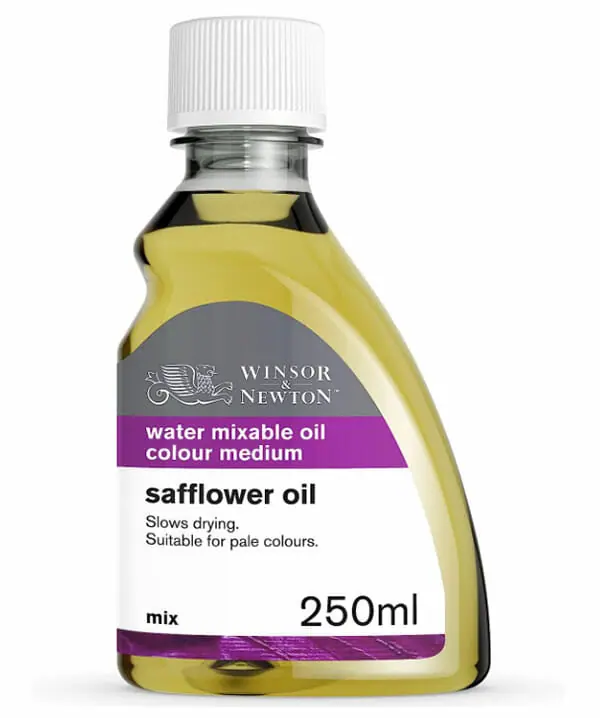
This is an oil paint medium for reducing viscosity and slowing down drying time. The Winsor & Newton brand also reduces the risk of yellowing, produces a glossy finish, and creates a softer paint film that prevents wrinkling.
Like safflower oil, poppy seed oil is an alternative to linseed oil. It’s less prone to discoloration and enhances the vibrancy of colors. However, like safflower oil, poppy seed oil produces a weaker paint film, decreasing durability. Painters mostly use poppy seed oil to slow drying time — it takes even longer to dry than linseed oil and safflower, so it’s very popular with painters who like to work in fine detail and need more time to finish working on each layer of paint. When compared to other oil-type oil mediums, poppyseed comes out the palest. However, it reacts pretty much the same. The only difference is that it is much more fluid — so it’s particularly useful for increasing the flow of paint for transparent glazes. It’s also very slow-drying, so you have even more time to work with it. In terms of use as a medium for oil painting, walnut oil isn’t that different from safflower and poppy oil. However, what’s notable about it is that it also works as a brush cleaner. So, if you want to work “solvent-free,” walnut oil is a good oil medium to have close at hand. It should also be said that walnut oil is no worse than safflower or poppy oil at reducing viscosity and enhancing paint colors. It even has a big advantage in that it produces a hard, durable film. The only catch is that walnut oil is not as stable. It can easily go bad once exposed to air. So, if you don’t pay attention to it, you might find that your walnut oil has gone rancid after leaving it out. This can be a bit troublesome, as you’ll have to store it in a cool place if the climate is particularly hot where you live. However, the benefits of walnut oil are still there and should be considered — especially if you live in cooler climates. This next recommended product is a medium for oil painting that is particularly good at enhancing the vibrancy of oil colors. It’s also useful for slowing down drying time, though it’s only moderately effective compared to other oil-type mediums. What you might care about most, however, is that it can actually be used as a safer, non-toxic brush cleaner — allowing you to work “solvent-free!” For our next oil paint medium, we have cold wax. Cold wax medium is a very thick paste that can be mixed with oil paints to add volume to your paints. Some painters may find it unnecessary as a medium for oil painting because of their chosen style. This cold wax is more useful for painters that are fond of more impressionistic styles with lots of texture and dimension. This painting style even has its own name — cold wax painting, so it’s not an oil paint medium that is strictly necessary for most painters. It should also be noted that using cold wax will increase drying time and result in a matte finish. One should also pay attention to the ratio in which it is used with oil paints because it’s a mixture of solvents, beeswax, resins, and oils. So, the previously mentioned “fat over lean” rule applies here as well — otherwise, your painting may become prone to cracking. The following are some of the more popular cold wax options in the market — each one has its own unique oil painting mediums recipes and may react differently: Gamblin cold wax’s consistency is a soft but thick paste. It is made primarily from beeswax and a mix of odorless mineral spirits, and some alkyd resin. Because of its unique paint-thickening characteristics, this oil medium is most useful for artists who like impasto and other similar techniques. This Michael Harding product is beeswax paste mixed with linseed stand oil and turpentine. It’s best at thickening paints and making them more elastic, which is just right for the cold-wax painting style. If you’re looking for oil mediums that will shorten drying time, alkyd resins are the best choice. This type of oil medium is often a mix of several mediums. Such a mixture will allow your paint to dry sooner and provides a flexible but firm surface finish — so glossy that it looks like glass. What’s more, alkyd mediums benefit from not being so fussy. Unlike cold-wax medium, you don’t have to follow the fat-over-lean rule strictly. Just remember not to use it with other oil mediums recklessly. Otherwise, your oil paints may come out unstable. Some examples of alkyd mediums that you can try are as follows: This Alkyd Medium is particularly fast-drying. Because the recipe includes walnut oil, it also has properties that can allow you to create transparent glazes for layered work. And, unlike some alkyd mediums, it’s solvent-free and perfectly safe to use. This product is an alkyd resin oil medium that is most useful for speeding up drying time. Some experts also like to use Galkyds to create transparent drip paintings, as it is particularly good at improving the flow of oil colors. Winsor & Newton’s Liquin is for artists whose techniques don’t require as much work time. It allows paints to dry more quickly between layers, allowing said artists to build up as many layers as they want without waiting too long. Neo Megilp is a gel medium that shortens drying time and improves the fluidity of oil paints. It’s best at the latter — even allowing artists to mimic the wet-on-wet techniques that are more commonly used in fluid watercolors. Linseed oil is the most commonly used oil medium. One reason is because of its strong compatibility with oil paint. And another is that it makes painting with oils more simple. For example, oil paints tend to ‘drag’ straight out of the tube. This is completely opposite of the free-flowing watercolor medium. Linseed oil helps with this, adding body to the oil colors and allowing you to paint more smoothly. No. You don’t necessarily need to use oil mediums. You can create oil paintings just fine without them. BUT, the process may not be as smooth as painting with oil mediums. This is especially true if you’re working with thicker paint. Not only is it wasteful not to use paint thinner, but it’s also laborious — you won’t have as smooth control over your brush strokes. It depends on what you’re using the oil medium for. The general rule of thumb is to prepare the oil medium nearby for use from the beginning. To avoid oil paints from cracking, you must avoid excessive use of lean medium and pay attention to the fat-over-lean rule when layering your paint. Doing this makes your layers “fatter” and thus more elastic. With the paint turning more flexible, you don’t have to worry about it contracting in the future — which is what forms cracks. The “Fat Over Lean” rule reminds artists to create ‘elastic over less elastic’ layers. To do this, you need to use more oil with each layer you apply — which is crucial to making your paintings last longer and less prone to cracking. Oil paints are sealed with varnish. You apply it on top of your painting to protect it from dirt particles and preserve your artwork. As a note, resins can also be used to seal paintings — creating a high-gloss film that’s similar to glass. Oil paints straight from the tube should have a buttery consistency and must be thinned out a bit for easier handling. If you’re still unsure about what consistency to work with, a good rule to remember is to paint ‘thick over thin.’ Never apply a thin layer on top of a thick layer of paint — it will cause layers to crack over time. Various oil mediums have working properties that can make your paintings shiny. If you’re looking for this effect specifically, add linseed oil or alkyd resins to your paints. It will result in a glossier finish. You should also avoid excessive use of mineral spirits and other solvents, as those will make your oil colors appear matte. Hopefully, you were able to gain some direction on which oil mediums suit your style of painting the most. If you’re still uncertain, the best method to find the right answer is to try the ones you think are closest to what you’re looking for. Don’t know which one to start with? Try linseed oil first! It’s cheap, non-toxic, and has many interesting working properties for you to experiment with. All in all, Linseed oil is the most commonly used oil medium for a reason. It’s also compatible with most other mediums. So, when you want to try other ones in the future, there’s not as much risk in ruining the paintings that you’ve spent so much time on. Featured Image: SourcePros
Cons
Poppy Seed Oil
Grumbacher Poppy Seed Oil Medium
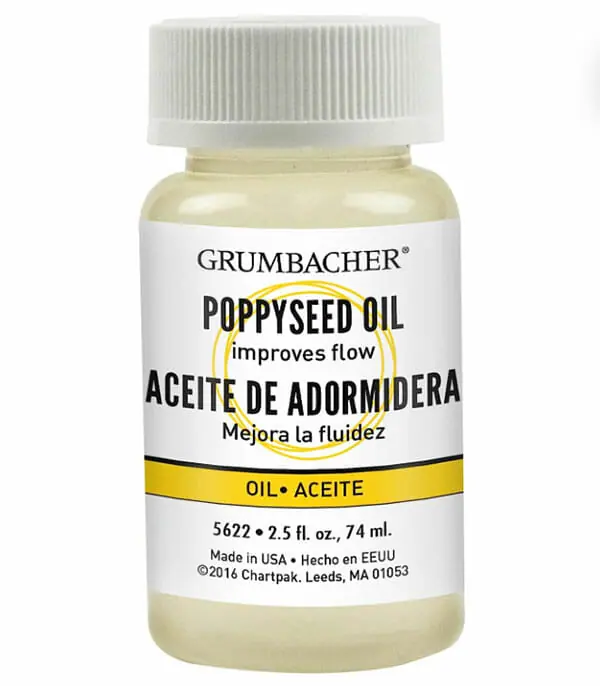
Pros
Cons
Walnut Oil
M. Graham Walnut Oil Medium

Pros
Cons
Cold Wax: Is it Necessary?
Gamblin Cold Wax Medium

Pros
Cons
Michael Harding Beeswax Paste

Pros
Cons
Alkyd Resin: Is it Necessary?
Graham Walnut Alkyd Medium

Pros
Cons
Gamblin Galkyd Oil Paint Medium

Pros
Cons
Winsor & Newton Liquin Original Oil Medium

Pros
Cons
Neo Megilp Alkyd Medium
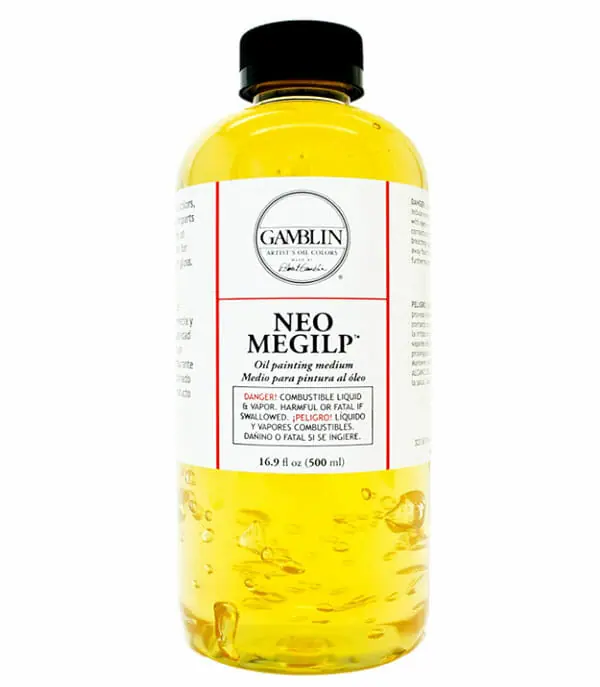
Pros
Cons
FAQs
What Is the Most Commonly Used Oil Painting Medium?
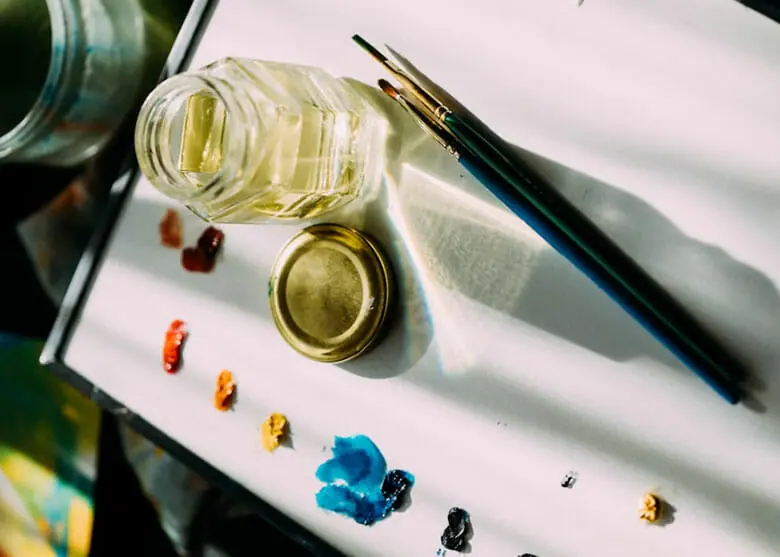
Is it Necessary to Use Oil Mediums?
When to Use Oil Paint Medium?
How to Prevent Oil Paint from Cracking?

What Does Fat over Lean Mean in Oil Painting?
How Can You Seal Oil Paint?
What Is the Best Consistency for Oil Painting?
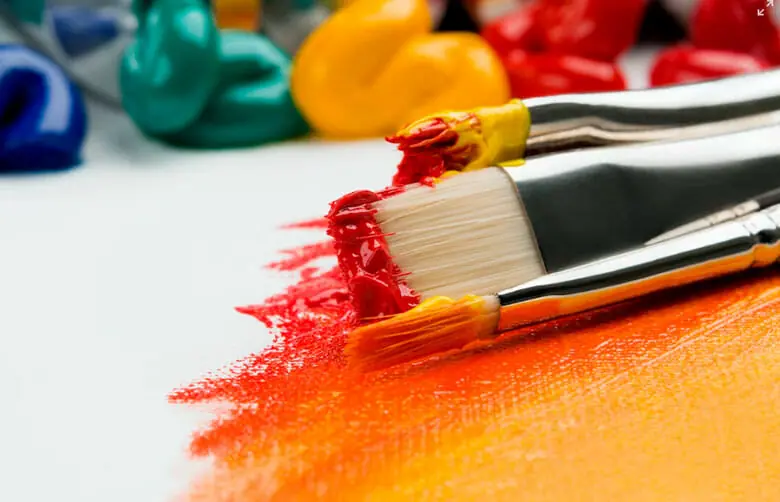
What Makes Oil Paintings Shiny?
Final Thoughts







